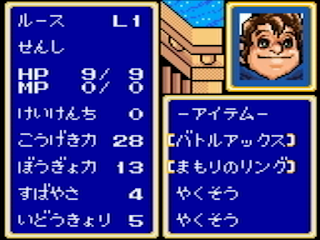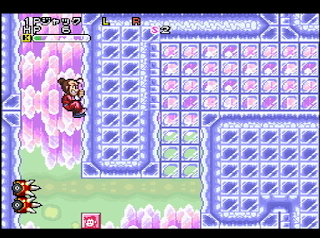Vixen 357 (ヴィクセン357)
Release Date: 10/23/1992
System: Mega Drive
Developer: Masaya Games
Publisher: Nihon Computer
This is a mecha game by Masaya, the same company that did the Langrisser series. This is not much like Langrisser, though. It’s the sequel to a 1990 PC Engine game called Hisou Kihei X-SERD (see a review and information here). I had rejected X-SERD as being an SRPG but that review mentions that the mechs can gain experience so it might actually qualify. In any case, this one definitely does
The opening sequence shows the various pilots with some animation and their names.
The instruction manual gives the backstory (also given before stage 1). In 2384, there was a war against an alien invasion, beaten back by the help of the new robot units called X-SERD. Earth took a lot of damage, and in order to deal with any future invasions, lots of time and money was poured into new weapons. But this also increased people’s greed and ambition as well. In 2396, a new country called Merismahap developed VECTOR units, and created a battle squad composed only of these new units to test them (called Slash). The goal is to have the robots operate on their own, but for now pilots are necessary.
Murasawa Takuya, along with other pilots, is part of Slash and practicing at a test base. One day away from the base, they receive word that it’s being attacked by an unknown squadron of Vectors. They return to the base to protect it, and that’s where the game starts.
I’m conflicted on whether to say a lot about the story or not. Since Vixen 357 has a translation patch, you can experience the story for yourself — on the other hand, some people might just be reading the entries without ever intending to play the game, and then could find story information useful.
Stage 1
The game starts out easy; you have three allies and then a bunch of NPCs attacking the enemies.
The “10” may remind you of Langrisser but it just represents the percentage of total HP the unit has left. The A and M show that the unit can still Attack or Move (or S for Special ability). I like that they displayed all that information in a clear, non-intrusive way.
Each unit has a melee and ranged attack. The dots next to the pilot show their ability in Hit and Evade for melee and shooting. Levelling the pilots up doesn’t seem to do a whole lot; it adds a few points to their stats but takes quite a while to even gain one extra circle. Takuya is good at both melee and shooting, although the starting configuration for his mech has a much better melee weapon. Melee fights allow for counterattacks, ranged weapons do not.
Each battle has a short fighting sequence which can be turned off via options, but (as with Lady Phantom) they don’t display any information about the result of the battle. If you are playing on an actual console it’s probably worth doing in some of the later missions with lots of enemies, but on an emulator I found it better just to hold down the speedup button so I could better see what was happening.
The NPCs soak up enough hits that this first stage is fairly easy; the game does have permadeath so you have to be careful, but you can save at any time.
Stage 2
In Stage 2 we get the ship, Dread. Now units can return to the ship to heal, and also to switch mechs, or to switch weapons on a mech (although you have to wait until the next turn to leave again). Having this flexibility is nice, particularly with some of the more specialized units (like the one that’s good in water).
Standing on the castle areas gives you +50% terrain bonus which is nice.
Stage 3
Lots of water on this stage, which is bad (-20% terrain).
The Dread has the special ability to heal itself, but it can only be used 5 times. Other pilots can use their special abilities as long as they have MP and then refill their MP in the ship, but once the Dread runs out of healing it’s out until the next stage. There is no way to heal other than the ship or these special abilities, so you have to be careful about how much you let the ship get damaged.
Stage 4
Another big water stage, but this time at least the game gives you one mech that’s good in water. There are also a lot of NPC units that help. This game is probably the most generous SRPG I’ve played in terms of NPCs that are actually somewhat effective.
The game still is not very difficult.
Stage 5
This stage has a lot of enemies, but I didn’t find it that difficult — the ship barely took any damage, and the counter attacks devastated the enemies. As the game progresses, more heroes and mechs join, and new weapon choices become available.
Stage 6
There’s a trick to this stage because one of the new “allies” turns traitor along with some of his units. If you went forward too quickly you get pincered and can take a lot of hits, but as long as everyone is on the right of you the new units don’t present that much of a concern.
This stage also introduces two annoying special abilities that will be around for the remainder of the game: Vacuum Wall, which gives every unit in range a shield that blocks several attacks. The second (which may actually show up next time) is Marb Clamp, which damages all units in range (and gets through the Vacuum Wall shield).
Stage 7
Here we get our own special mechs — two girls piloting the Fairy and Panacea, which have the special abilities I described in the last stage. They are NPCs under attack, but they actually head for your ship and dock to heal, which is nice given the common AI in these SRPGs.
 |
| The team |
Stage 8
I found this stage fairly difficult. Several enemies have the special abilities — fortunately they can’t recover their MP so it is a viable strategy to just send one or two units in to waste their abilities. There is apparently a 100 turn limit on every stage but that’s hard to reach even if you take your time.





































































